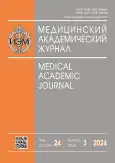Dexamethasone-induced changes in the expression profile of “neuroinflammatory” genes
- Authors: Tiutiunnik T.V.1, Kudrinskaya V.M.1, Obukhova D.A.1, Maystrenko V.A.1, Pestereva N.S.1
-
Affiliations:
- Institute of Experimental Medicine
- Issue: Vol 24, No 3 (2024)
- Pages: 133-138
- Section: Original research
- URL: https://bakhtiniada.ru/MAJ/article/view/277942
- DOI: https://doi.org/10.17816/MAJ630012
- ID: 277942
Cite item
Abstract
BACKGROUND: Glucocorticoids play an important role in the development of the stress response in the organism. Synthetic glucocorticoids such as dexamethasone are widely used in medicine due to their anti-inflammatory effects. However, there is evidence that glucocorticoid-based drugs used in sufficiently high doses can induce pro-inflammatory effects by affecting predominantly the hippocampus in the central nervous system as the most plastic brain structure. It is important to note that the dose, route and timing of administration can affect the effects of glucocorticoids, and it is therefore an important biomedical task to choose the optimal parameters of glucocorticoid administration in order to achieve the most effective treatment results.
AIM: The aim of our study was to investigate the effect of peripheral administration of a synthetic glucocorticoid, dexamethasone, at a dose of 8 mg/kg on the development of neuroinflammation in the rat hippocampus at different periods after administration.
MATERIALS AND METHODS: Thirty-two sexually mature male Wistar rats distributed into 8 groups of 4 animals each were used in the experiment. The animals were injected with dexamethasone at a dose of 8 mg/kg and decapitated for different periods (1, 3, 9, 12, 18, 24, 48 hours — time of decapitation after administration), group К — control group with saline injection). Further, the cytokine profile expression was analyzed by real-time reverse transcription polymerase chain reaction method.
RESULTS: In this study, we found an increase in the expression of proinflammatory cytokines AIF1 (IBA-1) and IL-1β after 12 and TNF-α after 24 hours after dexamethasone administration at a dose of 8 mg/kg, which may indicate a neuroinflammatory effect of dexamethasone at this dose. It should be noted that the level of NF-êB gene, a marker of inflammation, remained unchanged, possibly due to the activation of compensatory mechanisms to control inflammation or stress.
CONCLUSIONS: The increase in mRNA of inflammatory markers IL-1β, TNF-α and AIF1, in the hippocampus after 12 hours after single dexamethasone administration to rats at a dose of 8 mg/kg may indicate a switch of the effect of this drug from antiinflammatory to proinflammatory, which should be taken into account when dexamethasone is used such a treatment during several diseases.
Keywords
Full Text
##article.viewOnOriginalSite##About the authors
Tatiana V. Tiutiunnik
Institute of Experimental Medicine
Author for correspondence.
Email: t.tanjon11@yandex.ru
ORCID iD: 0000-0002-2427-9355
SPIN-code: 5440-6221
postgraduate student
Russian Federation, Saint PetersburgValentina M. Kudrinskaya
Institute of Experimental Medicine
Email: v.kudrinskaja2011@yandex.ru
ORCID iD: 0000-0002-2763-5191
SPIN-code: 4150-3364
research assistant
Russian Federation, Saint PetersburgDaria A. Obukhova
Institute of Experimental Medicine
Email: obuhowadaria@gmail.com
ORCID iD: 0009-0002-4287-0808
SPIN-code: 3164-3927
research assistant
Russian Federation, Saint PetersburgViktoriya A. Maystrenko
Institute of Experimental Medicine
Email: sch_viktoriya@mail.ru
ORCID iD: 0000-0001-7004-7873
Junior Research Associate
Russian Federation, Saint PetersburgNina S. Pestereva
Institute of Experimental Medicine
Email: Pesterevans@yandex.ru
ORCID iD: 0000-0002-3104-8790
SPIN-code: 1088-6479
Senior Research Associate
Russian Federation, Saint PetersburgReferences
- De Keyser J, Zwanikken CM, Zorgdrager A, et al. Treatment of acute relapses in multiple sclerosis at home with oral dexamethasone: a pilot study. J Clin Neurosci. 1999;6(5):382–384. doi: 10.1054/jocn.1997.0086
- Bolshakov AP, Tret’yakova LV, Kvichansky AA, Gulyaeva NV. Glucocorticoids: Dr. Jekyll and Mr. Hyde of Hippocampal Neuroinflammation. Biochemistry (Mosc). 2021;86(2):156–167. doi: 10.1134/S0006297921020048
- Nissen RM, Yamamoto KR. The glucocorticoid receptor inhibits NFkappaB by interfering with serine-2 phosphorylation of the RNA polymerase II carboxy-terminal domain. Genes Dev. 2000;14(18):2314–2329. doi: 10.1101/gad.827900
- Herculano-Houzel S, Watson C, Paxinos G. Distribution of neurons in functional areas of the mouse cerebral cortex reveals quantitatively different cortical zones. Front Neuroanat. 2013;7:35. doi: 10.3389/fnana.2013.00035
- Chai Z, Alheim K, Lundkvist J, et al. Subchronic glucocorticoid pretreatment reversibly attenuates IL-beta induced fever in rats; IL-6 mRNA is elevated while IL-1 alpha and IL-1 beta mRNAs are suppressed, in the CNS. Cytokine. 1996;8(3):227–237. doi: 10.1006/cyto.1996.0032
- Frank MG, Hershman SA, Weber MD, et al. Chronic exposure to exogenous glucocorticoids primes microglia to pro-inflammatory stimuli and induces NLRP3 mRNA in the hippocampus. Psychoneuroendocrinology. 2014;40:191–200. doi: 10.1016/j.psyneuen.2013.11.006
- Espinosa-Oliva AM, de Pablos RM, Villarán RF, et al. Stress is critical for LPS-induced activation of microglia and damage in the rat hippocampus. Neurobiol Aging. 2011;32(1):85–102. doi: 10.1016/j.neurobiolaging.2009.01.012
Supplementary files






